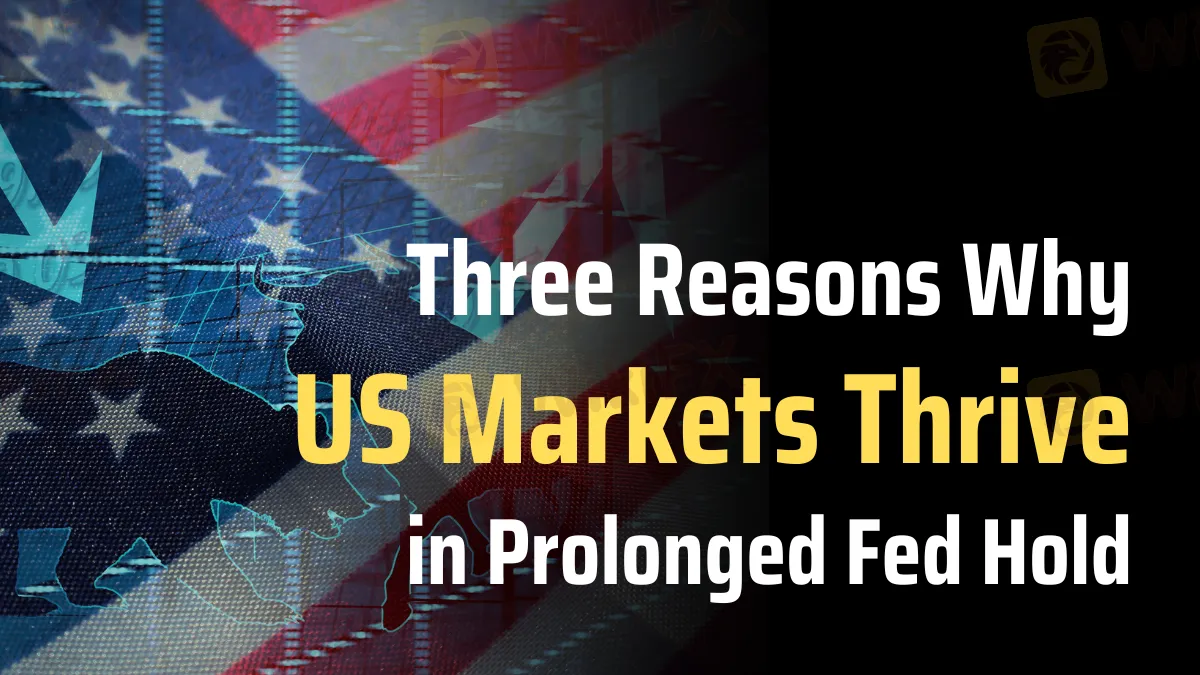简体中文
繁體中文
English
Pусский
日本語
ภาษาไทย
Tiếng Việt
Bahasa Indonesia
Español
हिन्दी
Filippiiniläinen
Français
Deutsch
Português
Türkçe
한국어
العربية
Three Reasons Why US Markets Thrive in Prolonged Fed Hold
Abstract:The surprising resilience of US financial markets under prolonged high Fed rates reveals three unique factors mitigating systemic risks.

The US financial markets have exhibited astonishing resilience in the face of the Federal Reserve's most prolonged period of high interest rates in more than four decades, in an extraordinary turn of events. Markets are proceeding without substantial disruptions, despite concerns that these “restrictive” policies, as Chair Jerome Powell has referred to them, could potentially undermine the economy. The following are three critical factors that elucidate the difference between this period and others, as well as how these elements contribute to a stable financial landscape.
1. The Privatization of Risk
The financial ecosystem has undergone a substantial transformation to the extent that risk is increasingly privatized. In contrast to the public market collapses of 2000 and 2007, which were visible to all and precipitated widespread hysteria, a significant portion of today's financing takes place in the shadows. Private entities, including pension funds, endowments, family offices, and ultra-wealthy individuals, are now more prominently involved in lending, circumventing the stricter regulations that govern public financial institutions.
This trend indicates that the likelihood of immediate contagion regarding prospective issues within the financial system is reduced. For instance, herd behavior that frequently results in market collapses is prevented by the fact that missed interest payments by private entities do not generate public headlines. Additionally, the risk of precipitous financing stops is mitigated by the relatively low likelihood of investors in private credit funds, including pension funds and insurance companies, to abruptly terminate their investments.
Nevertheless, this privatization is not without its own set of associated hazards. The potential for lower underwriting standards and the opacity of the private credit market has been emphasized by the International Monetary Fund (IMF) in response to the increased pressure to finalize transactions. In the event of a substantial market decline, there are concerns regarding the “layers of leverage” that exist within this ecosystem, which could potentially compound disruptions.
2. The Growth-Powered Government Debt
An additional distinctive feature of the current financial stability is the function of government debt in driving economic growth. Federal spending is a substantial contributor to the current period, in contrast to previous expansions that were fueled by corporate or household borrowing. In 2023, government expenditure was the primary source of GDP growth, with the highest percentage in over a decade, primarily funded by debt.

Inherently less hazardous than private debt, government debt is generally regarded as secure due to the federal government's capacity to tax. Unfortunately, the costs of this borrowing are on the rise, and there are concerns regarding the fiscal trajectory's sustainability. Although these concerns are valid, it does not appear that the current level of debt has yet reached a critical threshold that would result in a substantial increase in yields and the destabilization of the economy.
3. Fed's Balanced Approach
Maintaining market stability has also been significantly influenced by the Federal Reserve's strategy for managing elevated interest rates. Despite the fact that the Federal Reserve has implemented vigorous rate hikes and reduced its bond portfolio, it continues to exhibit a high degree of sensitivity to potential negative outcomes. Exemplifying this vigilance is the central bank's prompt intervention during the collapse of Silicon Valley Bank in March 2023.
Strategic communication by the Federal Reserve has been instrumental in mitigating market volatility and ameliorating financial conditions. This has necessitated a meticulous equilibrium: the preservation of a “tight” monetary policy while preventing the economy from spiraling into recession. In spite of the elevated interest rates, the Federal Reserve's interventions and signaling have maintained relatively benign financial conditions, thereby averting substantial fluctuations.
In spite of this, the Federal Reserve's capacity to oversee all facets of the financial system is restricted. Particularly in sectors with less regulatory supervision, such as fintech lending, and among low-income households, high interest rates have generated tension. Prolonged high rates have yet to completely test the resilience of the broader financial system and consumer markets.

In summary,
To conclude, the current stability of the US financial markets, despite the protracted high interest rates, can be attributed to a combination of factors. Within the opaque domains of private credit markets, the privatization of risk has served to mitigate potential contagions. Government debt has been instrumental in maintaining economic expansion, despite the increasing apprehensions regarding fiscal sustainability. Finally, the Federal Reserve's strategic communication and balanced approach have facilitated the management of market expectations and the diminution of potential downturns. Although these components have thus far maintained market stability, the inherent risks and potential stress points indicate that it is imperative to exercise caution when navigating this unprecedented economic environment.
You may access the financial latest news here.

Disclaimer:
The views in this article only represent the author's personal views, and do not constitute investment advice on this platform. This platform does not guarantee the accuracy, completeness and timeliness of the information in the article, and will not be liable for any loss caused by the use of or reliance on the information in the article.
Read more

Harsh Truths About ATC Brokers Every Trader Must Know
Many regulated brokers hide the risks associated with them. They never talk about these risks and try to attract customers with appealing offers. Later on, customers discover these hidden risks and feel disappointed. Before you come across a similar situation, we want to let you know the risks involved with ATC Broker. Check out the article to discover the harsh truth about it.

8 Golden Rules to Rule in the Forex market
These are important rules that most people won’t tell you. Whether you’re new to Forex beginner or have been trading for a while, these tips can help improve your trading journey. Read this article to learn the key rules every trader should keep in mind.

5 Clear Reasons Why Ultima Markets Is Smart Investment?
The Right Investment is hard to find these days. The Forex market is full of scam brokers, and it's a tough task to find the trusted ones. However, you can check out this article to discover 5 specific reasons why Ultima Markets stands out as a reliable choice.

JAFX - Where Investors Face Withdrawal Issues & Unprofessional Behavior
Are you facing withdrawal issues with JAFX? Are its executives asking you to pay a fee to get withdrawals? Accepted withdrawals failing to hit your wallet? You are virtually scammed by the company. Explore this story containing a wide range of issues investors face at JAFX.
WikiFX Broker
Latest News
PrimeXBT Launches MT5 PRO Account for Active Traders
Renault shares plunge 16% after French carmaker lowers guidance, appoints new interim CEO
Darwinex Launches INDX: A Revolutionary Investment Strategy for Traders
Top Forex Trading Scams to Watch Out for in 2025
eToro Expands into Singapore with MAS CMS Licence
Real Risk Factors with Admiral Markets ! Explained
5 things to know before the stock market opens Wednesday
5 Reasons to Know Why INFINOX Is a Standout Broker?
Trump's big beautiful bill' caps student loans. Here's what it means for borrowers
Weekly mortgage demand plummets 10%, as rates and economic concerns rise
Currency Calculator


